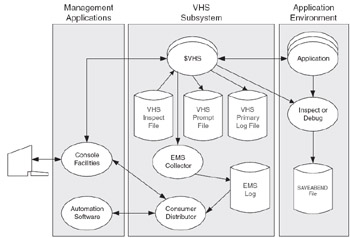Virtual Hometerm Subsystem (VHS)
VHS acts as a virtual home terminal for applications by emulating a terminal. It runs as a named process, usually $VHS.
VHS receives messages normally sent to the home terminal, such as displays, application prompts, run-time library errors, and Inspect or Debug prompts. VHS uses these messages to generate event messages to the EMS collector to inform operations staff of problems.
VHS can be used with operator console applications, such as ViewPoint or Non- Stop NET/MASTER software, to highlight system or application problems.
VHS improves operations productivity by helping to avoid three known problems related to using dedicated physical home terminals:
Inability of operations staff to find and respond to critical messages because of the large volume of routine messages.
Need for constant monitoring of physical home terminals by operations staff.
Loss of productivity due to a stopped terminal that is waiting for a response. VHS emulates a terminal, but does not have the disadvantages of a single, dedicated physical terminal. VHS gives the following benefits over a physical terminal:
Easy access to critical application messages
Centralized message handling
Freeing up of physical terminals
Automated handling of Inspect or Debug prompts
Improved availability of applications to end users
Highlighted information to expedite problem resolution
RISK $VHS, the Virtual Hometerm Subsystem, is widely used on HP Non- Stop systems. There is no risk associated with this product.
AP-ADVICE-VHS-01 If there are processes relying upon the availability of $VHS, then $VHS should be running.
The VHS Components
The VHS subsystem consists of the following components (See Figure 6-10):
VHS Process
VHS Conversational Interface (VHSCI)
VHS Pathway Browser Application
VHSCSTM
VHS Prompt File

Figure 6.10: VHS Compenents
VHS sends event messages to the EMS collector and optionally to a console facility for display only.
VHS
The $VHS process receives messages of many types from many sources. VHS manages six types of messages: open messages, display messages, Inspect prompts, Debug prompts, application prompts, and reply messages. The VHS process emulates a hardcopy terminal.
VHS is an application that is normally run from a separate subvolume on $SYSTEM, usually, $SYSTEM.VHS. The VHS object file is VHS.
VHSCSTM
The VHSCSTM file is used to customize each user 's VHSCI session. Please refer to the Gazette section on *CSTM Configuration Files.
VHS Conversational Interface
VHS conversational interface (VHSCI) is used to configure and query the VHS process. This is normally only used by the person responsible for starting, stopping and configuring $VHS.
VHS Primary Log File Set
The VHS Audit Trail contains all of the messages received by VHS . The audit trail is made up of up to five files. The logs are kept in the $SYSTEM.VHS subvolume as ALOGnnn.
VHS Prompt File
VHS stores application prompt messages in the Prompt File.
VHS Browser
The VHS Pathway Browser makes the VHS Audit Trail and Prompt files accessible to general users. Through Pathway screens, messages can be reviewed, searches for specific messages can be requested , and messages can be printed.
The components to the VHS Pathway Browser are:
PATHCTL
POBJDIR
POBJCOD
VHSBCONF
VHSBHELP
VHSBSVR
VHSBTEXT
Securing VHS Components
BP-PROCESS-VHS-01 $VHS process should be running.
BP-FILE-VHS-01 VHS should be secured "UUCU".
BP-OPSYS-OWNER-03 VHS should be owned by SUPER.SUPER.
BP-OPSYS-FILELOC-03 VHS resides in $SYSTEM.VHS.
BP-FILE-VHS-02 VHSCI should be secured "UUNU".
BP-OPSYS-OWNER-03 VHSCI should be owned by SUPER.SUPER.
BP-OPSYS-FILELOC-03 VHSCI resides in $SYSTEM.VHS.
BP-PROCESS-ZVHS-01 $ZVHS process should be running.
BP-FILE-VHS-03 VHS Browser Pathway application should be secured "NUNU".
BP-OPSYS-OWNER-03 VHS Browser components should be owned by SUPER.SUPER.
BP-OPSYS-FILELOC-03 VHS Browser components reside in $SYSTEM.VHS.
If available, use Safeguard software or a third party object security product to grant access to VHS object files to necessary personnel, and deny access to all other VHS .
BP-SAFE-VHS “01 Add a Safeguard Protection Record to grant appropriate access to the VHS object file.
BP-SAFE-VHS “02 Add a Safeguard Protection Record to grant appropriate access to the VHSCI object file.
| Discovery Questions | Look Here: | |
|---|---|---|
| FILE-POLICY | Is $VHS run on the system as a virtual terminal? | Policy |
| PROCESS-VHS-01 | Is the $VHS process running? | Status |
| PROCESS-ZVHS-01 | Is the $ZVHS Pathway process running? | Status |
| OPSYS-FILELOC-03 | Where is the installed VHS subvolume? | Fileinfo |
| OPSYS-OWNER-03 | Who owns the VHS subvolume files? | Fileinfo |
| FILE-VHS-01 | Is the VHS object file correctly secured with the Guardian or Safeguard system? | Fileinfo Safecom |
| FILE-VHS-02 | Is the VHSCI object file correctly secured with the Guardian or Safeguard system? | Fileinfo Safecom |
| FILE-POLICY | Are all users allowed to view the VHS log using the VHS browser? | Policy |
| FILE-VHS-03 | Is the VHS browser subvolume secured correctly? | Fileinfo |
Related Topics
Securing Applications